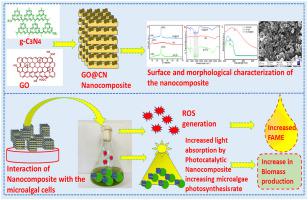Biomass & Bioenergy ( IF 5.8 ) Pub Date : 2023-04-16 , DOI: 10.1016/j.biombioe.2023.106802 Reetu , Aniruddha Jaiswal , Rajiv Prakash , Mike Clifford , Sarvajeet Singh Gill , Monika Prakash Rai

|
Low biomass yield and lipid production limits the development of microalgae-derived biodiesel on a wide scale. However, the use of photo-responsive nanomaterials as a substrate for microalgae can resolve these issues and enhance its economic viability. The current investigation highlights the potential of graphene oxide; graphitic carbon nitride (GO@CN) as a photocatalytic material for Chlorosarcinopsis sp. MAS04. A suite of characterization techniques including Scanning electron microscope (SEM), X-ray powder diffraction (XRD), Fourier transform infrared spectroscopy (FTIR), and Zeta potential was used to perceive the structural, morphological, and stability insights of the synthesized nanocomposite. Cytotoxicity assay for 96 h was performed for testing microalgal viability. Subsequently, microalgae cultures were supplemented with 0–200 mg L−1 of synthesized nanocomposite for 30 days. The intracellular reactive oxygen species (ROS) concentration was estimated to determine the oxidative stress burden. The incurred cellular lipids were processed into fatty acid methyl esters (FAMEs) possessing suitable biodiesel characteristics. The 50 mg L−1 of the optimal supplement of GO@CN for microalgae cultivation results in the highest biomass and lipid production of 3.825 g L−1 and 38.5% respectively, that is a 1.5-fold increase in biomass and nearly a 1.9-fold rise in lipid content, compared to the control. Additionally, a cost-benefit analysis of the developed process inferred a 350% increase in FAME yield at an expense of 0.15 g/INR more than the cost estimated for the control. Thus, this amalgamation of nano-algal science could be a prospective approach for augmenting microalgae-based biodiesel as a sustainable bioeconomy.
中文翻译:

一种使用光催化 GO@CN 辅助培养 Chlorosarcinopsis sp. 提高生物柴油生产的可持续生物经济方法。MAS04
低生物质产量和脂质产量限制了微藻衍生生物柴油的大规模开发。然而,使用光敏纳米材料作为微藻的基质可以解决这些问题并提高其经济可行性。目前的调查突出了氧化石墨烯的潜力;石墨氮化碳 (GO@CN) 作为Chlorosarcinopsis sp . 的光催化材料。MAS04。一套表征技术,包括扫描电子显微镜 (SEM)、X 射线粉末衍射 (XRD)、傅里叶变换红外光谱 (FTIR) 和 Zeta 电位用于感知合成纳米复合材料的结构、形态和稳定性见解。进行 96 小时的细胞毒性测定以测试微藻活力。随后,微藻培养物补充 0–200 mg L −1的合成纳米复合材料 30 天。估计细胞内活性氧 (ROS) 浓度以确定氧化应激负担。产生的细胞脂质被加工成具有合适生物柴油特性的脂肪酸甲酯 (FAME)。用于微藻培养的 GO@CN 最佳补充剂的50 mg L-1导致最高的生物量和脂质产量为 3.825 g L-1和 38.5%,与对照相比,生物量增加了 1.5 倍,脂质含量增加了近 1.9 倍。此外,对开发过程的成本效益分析推断,FAME 产量增加了 350%,而成本比对照的估计成本高出 0.15 g/INR。因此,这种纳米藻类科学的融合可能是一种前瞻性的方法,可以将基于微藻的生物柴油作为一种可持续的生物经济。











































 京公网安备 11010802027423号
京公网安备 11010802027423号